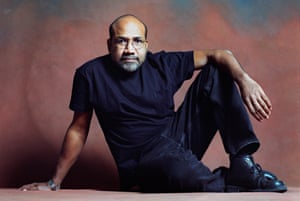Garth Risk Hallberg on how fiction can ‘make it new’
In his 1992 novel, Texaco, the Antillean writer Patrick Chamoiseau fuses a vast range of materials into an epic of the dispossessed. The author of acclaimed new novel City on Fire salutes this path-breaking bricolage
Garth Risk Hallberg
Thursday 15 October 2015 16.00 BST
I
was 21 and in uneasy transit between the visions of the poet and the compromises (I thought) of prose, when an older poet brought me a novel – a sturdy Granta Books hardcover, published a few years earlier. Its author’s name, Patrick Chamoiseau, didn’t ring any bells. Nor had I learned yet to appreciate those virtues its greyscale jacket evoked. Dignity. Maturity. Sobriety. Of Martinique, the book’s setting, I knew essentially nothing. Yet a peculiar contrast sparked my imagination. Beneath a muted photograph of a labourer’s folded hands was a trademark from the junk-culture landscape I had grown up in: Texaco.
The effect, for me, was of a smiley-face slapped on to that Van Gogh painting of the boots. Or of a Donald Barthelme story crash-landing in the middle of Let Us Now Praise Famous Men. Or perhaps it’s simpler to say that the effect was to scramble my assumptions about the range of textures a single piece of prose might encompass. And that was just the cover. I carried the book back to my matchbox apartment and started reading it. As I recall, I didn’t stop except for food and sleep until, two days and 400 pages later, I reached the end.
Chamoiseau, it turned out, had been a poet, too, at the start – and in this way, like me, an exile at the gates of the novel. A Martinican of African descent, citizen of a former French colony, he also had a necessarily complicated relationship with the literary traditions of the metropole. His early critical writing (according to an afterword) explored the tensions between a French “more French than that of the French” and an ideal he called “Creolité”. But in Texaco, he not only braved these tensions; he turned them into drama. Among the supporting cast, for example, is one Monsieur Gros-Joseph, a bourgeois merchant who has amassed a library of classics as a kind of bulwark against the dissonance of colonial life. With the outbreak of the second world war – a revelation of dissonance even at the heart of the empire – Monsieur Gros-Joseph loses his mind and begins quite literally to devour his books.
The poems, the wretch would say, tasted better than the novels – more delicate. Rimbaud gave off a taste of silty cockle, something that choked and tortured the mouth before spreading out layers of smells, then turning into a sheaf of powder and desert sand. Lautréamont reigned in a bouquet of star-apple-green-lemon, but in large quantities would cause stomach ache. And Montaigne, alas, oh flamboyant spirit ... his books dissipated their virtues in the mouth only to leave the taste buds the impression of stale paper. Ah Zola taste of shit, Ah Daudet taste of shit, and he would fling them across the room, pages torn by his teeth.
I was reading all this in English, of course, my own French having stalled around “Voulez-vous coucher avec moi”, but I could glean from Rose-Myriam Rejouis and Val Vinokurov’s translation that Chamoiseau’s language was not that of the Académie – or not only that. Studding the long sentences like petals on a bough were “booboos” and “bekés” and “the Noutéka of the hills”; “Mentohs”, asbestos, and the “pissied” city streets. And vining around the main narrative in similar profusion were folktales and folk wisdom and an endless, vivid catalogue of the windfalls harvested by the urban poor of Martinique: “a box of wrapping paper to line a hutch, a pan to reinforce a shaken facade, a fork, a cracked plate, a piece of tulle, a bottle, a string ... ”
These bricoleurs, the dispossessed rather than the merchant class, are the novel’s real subject. Texaco takes its name from the shantytown they construct after the war, a sprawl of crate-wood hutches hard by the oil tanks that fuel the capital city of Fort-de-France. For years, as the novel opens, police from the city centre have been conducting raids on the Texaco quarter, levelling homes, asserting property rights under the banner of public safety. Lean-tos can always be rebuilt – hence those long lists of scavenged materials. But now, in the 1980s, a new threat has appeared: an urban planner with visions of a more permanent incursion.
A prologue follows him as he wanders around Texaco, studying its hutches, assessing “the usefulness of [its] insalubrious existence”. Layers of neighbourhood gossip muddle what happens next, but we know some things for certain. Offence is taken. A stone is thrown. Blood is drawn. Finally, the injured urban planner is brought to the community’s elder and co-founder, a septuagenarian “femme-matador” named Marie-Sophie Laborieux. “What’s the use of visiting something you’re going to raze?” she asks the planner, having poured him a glass of rum. And finding him at a loss for words, she says, “Little fellow, permit me to tell you Texaco’s story”.
The remainder of Texaco is that telling. Marie-Sophie begins 90 years before her own birth, when her grandparents are slaves on a sugar plantation. In a series of indelible set pieces, we learn of the manumission of her father, Esternome; of his unhappy attempts to find love and work as a freeman in “l’En-ville”; of the broader abolition of slavery in Martinique; and of the volcano that destroys the city of Saint-Pierre, sending Esternome and thousands of other refugees toward the capital. If Chamoiseau’s marked orality and in medias res opening have gestured toward epic, this section of the novel makes good on the promise, in the manner of One Hundred Years of Solitude, or Edward P Jones’s The Known World. “My poor Esternome” is a figure of great sympathy, beset from all sides, and his odyssey knits the origins of Texaco into the larger history of a people.
The central hero of Texaco, though, is Marie-Sophie, who commands the second half of the novel. After the death of her father, she goes to work as a servant in various households (among them the Gros-Josephs’). The situation of the merchants may improve with decolonisation, but that of the working classes, in Chamoiseau’s account, seems no better – just different. Marie-Sophie is in her own way as unlucky as her father; she cannot hold on to a job, or to love. But the stories she has inherited inoculate her against despair. Even as the urban planner encounters her – “an old câpresse woman, very tall, very thin, with a grave, solemn visage and still eyes” – she remains open to the world in all its richness and contradiction, and ingenious in building what she needs out of whatever is to hand. Unable to bear children, she becomes the mother figure of the resistance, distributing the gifts of nurture and nature to the broader family of the Texaco quarter. And her most resourceful construction is the novel itself, a feat of narrative prodigality that staves off, word by word, the destruction of an entire community.
This feat, to make an obvious point, is Chamoiseau’s, too. And interestingly, for all its formal dazzle, it succeeds because we believe so strongly in Esternome and Marie-Sophie and their vivid, tangled stories. Maybe at 21, I harboured a hope that Texaco would reject the dubious old magic of prose fiction – would, like Monsieur Grand-Joseph, fling character, plot and invention across the room, “torn by teeth”. Instead, by stirring them into its concretion of the oral and the written, the poetic and the prosaic, the local and the global, Texaco made everything I’d ever loved about reading feel new.
It seems to me at 36 that the source of Texaco’s literary power is precisely its hybridity, its capacious Creolité, its embrace of “both/and” where it would be easy to see an “either/or”. I’ve read enough now to recognise this as a venerable tradition, extending back to Scheherazade and Don Quixote and forward to Midnight’s Children and Beloved. It’s an aesthetic inseparable from the novel itself. But in a world of continued dispossession, of millions of people struggling merely for a home, Chamoiseau’s Creolité may point the way to an ethic, too – sceptical, imaginative, humane. At the very least, it wins over the urban planner of Texaco, who as the novel ends is ready to stand with Marie-Sophie against the wrecking balls and high-rises of the “domineering, geometrical grid”. Their resistance will likely be fragile, even doomed. But long after Texaco is gone, the vision she’s granted him will endure:
In the centre, an occidental urban logic, all lined up, ordered, strong like the French language. On the other side, Creole’s open profusion, according to Texaco’s logic. Mingling these two tongues, dreaming of all tongues, the Creole city speaks a new language in secret and no longer fears Babel. [...] The Creole city returns to the urban planner, who would like to ignore it, the roots of a new identity: multilingual, multiracial, multihistorical, open, sensible to the world’s diversity.
THE GUARDIAN
Granta / Best of Young American Novelists 3 / Introduction
Granta / Best of Young American Novelists 3 / Author Biographies
Granta’s list of the best young American novelists / 3
Granta’s list of the best young American novelists / 3
2002
2010
2013
2017
Beautiful and brutal / How James Salter set the standard for erotic writing
School of hard knocks / The dark underside to boarding school books
Rereading / Primo Levi’s If This is a Man at 70
Studs Terkel’s Working / New jobs, same need for meaning
My Cousin Rachel / Daphne du Maurier's take on the sinister power of sex
Beautiful and brutal / How James Salter set the standard for erotic writing
School of hard knocks / The dark underside to boarding school books
Rereading / Primo Levi’s If This is a Man at 70
Studs Terkel’s Working / New jobs, same need for meaning
My Cousin Rachel / Daphne du Maurier's take on the sinister power of sex






No comments:
Post a Comment